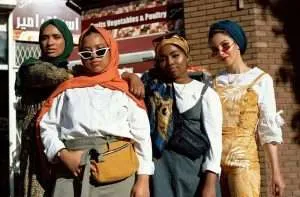Sociologists often discuss gender as socially constructed. Importantly, when discussing gender, sociologists are referring to the social characteristics, roles, and expectations attached to biological sex categories. To a sociologists, gender and sex—although related—are separate concepts with distinct meanings. So, what is the social construction of gender and how do the ways we talk about reproductive health contribute to the social construction of womanhood?
The Social Construction of Gender
Sociological works linking gendered experiences with reproductive health focuses largely on menstruation, infertility, and abortion. For example, Janet Lee explored menarche—or first menstruation—stories to understand meanings women attach to such experiences as well as how revisiting menarche experiences makes women think and feel. Through analysis of forty written and spoken narratives, Lee explains how menarche is commonly associated with feelings of contamination in reference to one’s body. Menarche is also associated with a hyperawareness of one’s body and its changing attributes—specifically breast and hip growth, but also gender presentation—and an abrupt dichotomization of male and female bodies and activities.
These explanations touch on the stigma associated with “having bodies that bleed,” the embodiment of gender through menstruation, and the role of first menstruation in creating a precise category for women, and more specifically the “ideal woman.”
Constructing Menstruation Stigma
Other scholars have expanded on the stigma of menstruation to explore the dissemination of menstruation stigma. When searching for sources of menstruation stigma, scholars often look towards cultural artifacts and media, including advertisements, newspaper articles, magazine articles, books, and television. These sources all told similar stories that depict menstruation as an embarrassing trait that should be hidden, both physically and conversationally.
These consequences of menstruation stigma mirror French philosopher Michel Foucault’s concept of self-surveillance, theories of objectification and self-objectification, and terror management theory—or the idea that menstruation reminds us of our mortality—all of which contribute to women’s lower social status in society. Lee, however, highlights the agency women exercise despite the restrictions that discursive constructions impose on women’s bodies and behaviors. Such agency emphasizes how women have the ability to reframe their experiences and therefore reconstruct feminine ideals.
The Social Construction of Gender and Menstruation
Katie Hasson is yet another scholar who discusses the social and material construction of menstruation. Hasson specifically explores the redefinition, or reconstruction, of menstruation in relation to hormonal birth control. The introduction of hormonal birth control as a way of controlling menstruation through a synthetic imitation of the natural bodily process redefined menstruation and its gendered embodiment. In other words, the once natural process is now controlled by synthetic hormones, changing the way we think about “doing” gender in relation to menstruation.
Hasson argues that this redefinition is an example of technology mediating the relationship between gender and the body. If, as Hasson argues, hormonal birth control redefines menstruation in relation to gender, then would it not also redefine, or at the least contribute to, discursive constructions of womanhood?
Infertility, Motherhood, and Womanhood
Related to explanations of menstruation stigma, Kitzinger and Willmott wrote about the gendered experience of women with polycystic ovarian syndrome (PCOS). Their research focuses primarily on the experiences of women through loosely structured interviews, allowing the women to cover parts of their narratives that are personally important to them.
Kitzinger and Willmott’s key findings hone the idea that women diagnosed with PCOS experience failure to live up to society’s expectations of the ideal woman. These finding are explained through women’s explanations of themselves as “freaks” because of “excess” hair, irregular menstrual cycles, and infertility. This collective understanding of infertility and menstrual irregularity excluded women from the “ideal woman” category. That exclusion then creates a gendered experience for women living with PCOS that does not fit the expected experience of womanhood as a socially constructed category.
Women as “Natural Mothers”
Related to research discussing how infertility affects women’s gendered experiences, scholars also aim to understand how popular discourse frames contraceptives in relation to women as natural mothers. The work of Gayle Letherby is on example.
Letherby extends the discussion on the stigma of infertility in women to include women who chose not to be mothers. In her work, Letherby highlights the similarities between voluntary and involuntary childlessness. She argues that regardless of whether childlessness is voluntary or involuntary, as in the case of infertility, childless women are labeled as “other.”
In Letherby’s argument, society has divided women into two categories: “mothers” and “others.” The stigmatization of women who are categorized as “others” is also important to this argument, where the expectation is that women are mothers, and childless or childfree women do not meet that expectation.
What about Adoptive Mothers?
Katarina Wegar’s work on adoptive mothers adds a vital take on the expectations that women are mothers. Through an analysis of clinical adoption literature between 1940 and 1990, Wegar concludes that stigma of infertility reigns true throughout the adoption process. More specifically, literature in 1990 framed coming to terms with infertility as “the most important precondition for the readiness to adopt.” Additionally, discussions regarding the possibility of adoptive fathers’ infertility were near absent.
Wegar’s work provides an interesting case where women who want to be mothers but cannot be biological mothers are still stigmatized as “others,” rather than fitting into the “mothers” category. This predicament raises questions as to whether it is women’s intentions or their biological abilities that matter more in the dichotomization of “others” and “mothers.”
Abortion and Motherhood
Scholarly works on abortion stigma raise similar questions about the importance of women’s intentions towards motherhood and their biological abilities to conceive. A woman who faces infertility and adopts does not have the biological ability to conceive, yet she wants to fill the role of a mother in society. On the other hand, a woman who terminates a pregnancy has the biological ability to conceive, but may be portrayed as choosing not to fulfill her role as a mother.
If we use Letherby’s work to make sense of women who get abortions, we might place them in the voluntarily childless category, where they would then be labeled as “other.” While women who have abortions occupy many different experiences and maintain vastly different motives for their actions, abortion stigma literature provides the argument that society pigeonholes the abortion experience. The narrow understanding of abortion experiences then allows for an overarching stigma to apply to all abortion experiences.
Constructing Abortion Stigma
Anuradha Kumar and colleagues‘ work operationalizes abortion stigma as “a negative attribute ascribed to women who seek to terminate a pregnancy that marks them, internally or externally, as inferior to ideals of womanhood.” This definition gives specific reference to ideals of womanhood, which scholars commonly understand as including motherhood.
Scholars have sought out sources of abortion stigma just as they have for menstruation stigma. This search for sources of stigma yielded an analysis of levels of the sources of abortion stigma. Kumar and colleagues give attention to framing discourses as the larger cultural level of abortion stigma. They describe framing discourses as mainstream language used in abortion discourse by women, medical providers, and media among other public and private platforms.
Their recognition of framing discourses in the construction of abortion stigma calls for critical analysis of language and discourse surrounding not only abortion but also contraceptives and other birth control methods. By bringing attention to discourse, and specifically the language we use to talk about reproductive health, we may be able to better understand the stigmas associated with various reproductive health issues for women.
Final Thoughts on the Social Construction of Gender and Reproduction Health
This article shed light on some overarching themes in the social construction of gender as it related to reproductive health issues. But, it only skims the surface of how reproductive health issues are framed through discourse. The framing of such issues often leads to stigma for women who don’t neatly fit into the boxes society has created for them. That includes women who live with reproductive health conditions like PCOS, those who face infertility, those who are voluntarily childless, and those who seek abortions.
Understanding the way our society constructs ideal of womanhood through discourse on reproductive health is an important step in releasing many women from the stigmas that currently plague them.
If you enjoyed this article, you might also like these!
- Gendered Experiences, Religiosity, and Well-being of Women during COVID-19
- The Sociology of Gender and How it can be Applied
- Eradicating the Male Gaze in the US Helps Women Everywhere
- Investing in Women’s Health Research Drives Positive ROI
- The Social Construction of Womanhood and Religion
- What is the Social Construction of Health and Illness?







